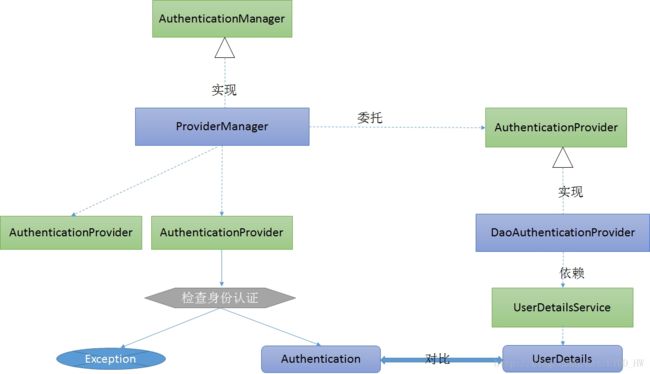Spring Secutity 自定义权限配置
Srping Security网上也有很多例子,但基本都是所资源直接配置在XML文件里,限制太大,不够灵活。我们需要的是可以在后台修改资源访问权限,实时生效,才能符合现在大多数系统的需求。
需要引入的依赖
<dependency>
<groupId>org.springframework.securitygroupId>
<artifactId>spring-security-webartifactId>
<version>4.2.2.RELEASEversion>
dependency>
<dependency>
<groupId>org.springframework.securitygroupId>
<artifactId>spring-security-configartifactId>
<version>4.2.2.RELEASEversion>
dependency>
用户身份认证
我们自定义一个实现类MUserDetailsService 来实现UserDetailsService接口。
其中需要实现一个loadUserByUsername方法,用来读取用户的角色。
在这里需要从数据库中通过用户名来查询用户的信息和用户所属的角色
其中MGrantedAuthority实现了GrantedAuthority接口,用于构建用户权限。
MUserDeatils实现了UserDeatils接口,用于存放用户信息与权限
UserDetailsService在身份认证中的作用
Spring Security中进行身份验证的是AuthenticationManager接口,ProviderManager是它的一个默认实现,但它并不用来处理身份认证,而是委托给配置好的AuthenticationProvider,每个AuthenticationProvider会轮流检查身份认证。检查后或者返回Authentication对象或者抛出异常。验证身份就是加载响应的UserDetails,看看是否和用户输入的账号、密码、权限等信息匹配。此步骤由实现AuthenticationProvider的DaoAuthenticationProvider(它利用UserDetailsService验证用户名、密码和授权)处理。包含 GrantedAuthority 的 UserDetails对象在构建 Authentication对象时填入数据。
MUserDetailsService.class中的loadUserByUsername方法
/**
* 根据用户名加载用户密码与权限信息
* @param username
* @return
* @throws UsernameNotFoundException
*/
@Override
public UserDetails loadUserByUsername(String username) throws UsernameNotFoundException {
//查询用户信息
User user = userMapper.selectByName(username);
List roleList = null;
MUserDeatils userDeatils = null;
if (user != null){
//查询用户的角色
roleList = roleMapper.queryByUser(user.getId());
System.out.println("user" + user.getUsername() + "----" + user.getPassword());
// 构建权限
Set authorities = new HashSet();
if (roleList.size() != 0){
for (Role role: roleList){
authorities.add(new MGrantedAuthority(role.getName()));
System.out.println(role.getName());
}
userDeatils = new MUserDeatils(user.getUsername(),user.getPassword(),authorities);
}
}
return userDeatils;
} MGrantedAuthority.class
public class MGrantedAuthority implements GrantedAuthority {
private String authority;
public MGrantedAuthority(String authority){
this.authority = authority;
}
@Override
public String getAuthority() {
return authority;
}
}MUserDeatils.class
实现UserDetails接口定义好变量即可
读取资源与所属角色
需要自定义实现类实现FilterInvocationSecurityMetadataSource接口。通过loadResourceDefine方法可以实现资源与权限的对应关系。
要使我们自定义的MFilterInvocationSecurityMetadataSource生效,我们还需要定义一个MyFilterSecurityInterceptor类。
这里的数据需要从数据库中取得。另外自定义接口UrlMatcher,实现类为AntUrlPathMatcher。
坑
网上有教程是把loadResourceDefine方法放在了构造函数里。但我经过多次试验均出现service,mapper无法注入的问题,然后就会报一个空指针的导异常,经debug发现是service没有注入。经多次查询得知:原因是构造方法会先于注入执行,所以loadResourceDefine方法放入构造中执行时函数内的service与mapper还未执行注入,因此报 java.lang.NullPointerException的异常。解决方法是将loadResourceDefine方法放在getAttributes方法中执行。
MFilterInvocationSecurityMetadataSource.class
@Component
public class MFilterInvocationSecurityMetadataSource implements FilterInvocationSecurityMetadataSource {
@Autowired
public IRescAndRoleService iRescAndRoleService ;
@Autowired
private IUserService iUserService ;
private UrlMatcher urlMatcher = new AntUrlPathMatcher();
// 资源权限集合
private static Map> resourceMap = null;
public void loadResourceDefine(){
resourceMap = new HashMap>();
//取得用户信息
List userList = iUserService.query();
//取得资源与角色列表
List resourceList = iRescAndRoleService.query();
System.out.println(resourceList);
for (RescAndRole resource : resourceList) {
Collection atts = new ArrayList();
atts.add(new SecurityConfig(resource.getRoleName() ));
resourceMap.put(resource.getResString(), atts);
}
}
@Override
public Collection getAttributes(Object o) throws IllegalArgumentException {
loadResourceDefine();//防止无法注入问题
// guess object is a URL.
String url = ((FilterInvocation) o).getRequestUrl();
Iterator ite = resourceMap.keySet().iterator();
while (ite.hasNext()) {
String resURL = ite.next();
if (urlMatcher.pathMatchesUrl(resURL, url)) {
return resourceMap.get(resURL);
}
}
return null;
}
@Override
public Collection getAllConfigAttributes() {
return null;
}
@Override
public boolean supports(Class aClass) {
return true;
}
} AntUrlPathMatcher.class
public class AntUrlPathMatcher implements UrlMatcher {
private boolean requiresLowerCaseUrl;
private PathMatcher pathMatcher;
public AntUrlPathMatcher() {
this(true);
}
public AntUrlPathMatcher(boolean requiresLowerCaseUrl) {
this.requiresLowerCaseUrl = true;
this.pathMatcher = new AntPathMatcher();
this.requiresLowerCaseUrl = requiresLowerCaseUrl;
}
public Object compile(String path) {
if (this.requiresLowerCaseUrl) {
return path.toLowerCase();
}
return path;
}
public void setRequiresLowerCaseUrl(boolean requiresLowerCaseUrl) {
this.requiresLowerCaseUrl = requiresLowerCaseUrl;
}
public boolean pathMatchesUrl(Object path, String url) {
if (("/**".equals(path)) || ("**".equals(path))) {
return true;
}
return this.pathMatcher.match((String) path, url);
}
public String getUniversalMatchPattern() {
return "/**";
}
public boolean requiresLowerCaseUrl() {
return this.requiresLowerCaseUrl;
}
public String toString() {
return super.getClass().getName() + "[requiresLowerCase='"
+ this.requiresLowerCaseUrl + "']";
}
}
MyFilterSecurityInterceptor.class
public class MyFilterSecurityInterceptor extends AbstractSecurityInterceptor
implements Filter {
private FilterInvocationSecurityMetadataSource securityMetadataSource;
public void doFilter(ServletRequest request, ServletResponse response,
FilterChain chain) throws IOException, ServletException {
FilterInvocation fi = new FilterInvocation(request, response, chain);
invoke(fi);
}
public FilterInvocationSecurityMetadataSource getSecurityMetadataSource() {
return this.securityMetadataSource;
}
public Class getSecureObjectClass() {
return FilterInvocation.class;
}
public void invoke(FilterInvocation fi) throws IOException,
ServletException {
InterceptorStatusToken token = super.beforeInvocation(fi);
try {
fi.getChain().doFilter(fi.getRequest(), fi.getResponse());
} finally {
super.afterInvocation(token, null);
}
}
public SecurityMetadataSource obtainSecurityMetadataSource() {
return this.securityMetadataSource;
}
public void setSecurityMetadataSource(
FilterInvocationSecurityMetadataSource newSource) {
this.securityMetadataSource = newSource;
}
public void destroy() {
}
public void init(FilterConfig arg0) throws ServletException {
}
}
决策管理器
自定义一个决策管理器MyAccessDecisionManager实现AccessDecisionManager接口。其中的decide方法,决定某一个用户是否有权限访问某个url
/* (non-Javadoc)
* @see org.springframework.security.access.AccessDecisionManager#decide(org.springframework.security.core.Authentication, java.lang.Object, java.util.Collection)
* 该方法决定该权限是否有权限访问该资源,其实object就是一个资源的地址,authentication是当前用户的
* 对应权限,如果没登陆就为游客,登陆了就是该用户对应的权限
*/
@Override
public void decide(Authentication authentication, Object object,
Collection configAttributes)
throws AccessDeniedException, InsufficientAuthenticationException {
if(configAttributes == null) {
return;
}
System.out.println(object.toString()); // object is a URL.
//所请求的资源拥有的权限(一个资源对多个权限)
Iterator iterator = configAttributes.iterator();
while(iterator.hasNext()) {
ConfigAttribute configAttribute = iterator.next();
//访问所请求资源所需要的权限
String needPermission = configAttribute.getAttribute();
System.out.println("访问"+object.toString()+"需要的权限是:" + needPermission);
//用户所拥有的权限authentication
Collection authorities = authentication.getAuthorities();
for(GrantedAuthority ga : authorities) {
if(needPermission.equals(ga.getAuthority())) {
return;
}
}
}
//没有权限
throw new AccessDeniedException(" 没有权限访问! ");
}
@Override
public boolean supports(ConfigAttribute attribute) {
// TODO Auto-generated method stub
return true;
}
@Override
public boolean supports(Class clazz) {
// TODO Auto-generated method stub
return true;
} 配置XML
web.xml
添加Seucrity的过滤器,将拦截所有资源访问
注意
只能配置成 /*
<context-param>
<param-name>contextConfigLocationparam-name>
<param-value>
WEB-INF/config/security.xml
WEB-INF/config/spring-mybatis.xml
param-value>
context-param>
<filter>
<filter-name>springSecurityFilterChainfilter-name>
<filter-class>org.springframework.web.filter.DelegatingFilterProxyfilter-class>
filter>
<filter-mapping>
<filter-name>springSecurityFilterChainfilter-name>
<url-pattern>/*url-pattern>
filter-mapping>spring-security.xml
<b:beans xmlns="http://www.springframework.org/schema/security"
xmlns:b="http://www.springframework.org/schema/beans" xmlns:xsi="http://www.w3.org/2001/XMLSchema-instance"
xsi:schemaLocation="http://www.springframework.org/schema/beans http://www.springframework.org/schema/beans/spring-beans.xsd
http://www.springframework.org/schema/security http://www.springframework.org/schema/security/spring-security.xsd">
<http pattern="/userLogin.html" security="none" />
<http pattern="/js/**" security="none" />
<http pattern="/css/**" security="none" />
<http pattern="/login" security="none" />
<http pattern="/getGrid" security="none" />
<http pattern="/favicon.ico" security="none" />
<http >
<access-denied-handler error-page="/accessHint.html">access-denied-handler>
<form-login
authentication-failure-url="/userLogin.html?error=true"
login-page="/userLogin.html"
default-target-url="/index.html"
login-processing-url="/j_spring_security_check" />
<logout invalidate-session="true"
logout-success-url="/userLogin.html"
logout-url="/j_spring_security_logout"/>
<custom-filter ref="filterSecurityInterceptor" before="FILTER_SECURITY_INTERCEPTOR" />
<csrf disabled="true" />
http>
<b:bean id="filterSecurityInterceptor"
class="com.hand.security.utils.MyFilterSecurityInterceptor">
<b:property name="rejectPublicInvocations" value="true"/>
<b:property name="accessDecisionManager" ref="accessDecisionManager" />
<b:property name="authenticationManager" ref="authenticationManager" />
<b:property name="securityMetadataSource" ref="securityMetadataSource" />
b:bean>
<authentication-manager alias="authenticationManager">
<authentication-provider
user-service-ref="mUserDetailsService">
authentication-provider>
authentication-manager>
<b:bean id="mUserDetailsService" class="com.hand.security.service.impl.MUserDetailsService" />
<b:bean id="accessDecisionManager" class="com.hand.security.utils.MyAccessDecisionManager">b:bean>
<b:bean id="securityMetadataSource" class="com.hand.security.utils.MFilterInvocationSecurityMetadataSource" >b:bean>
b:beans>